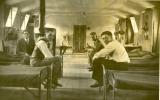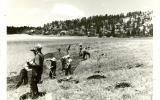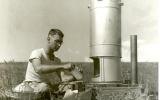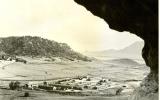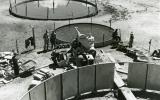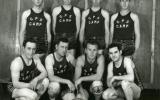CPS Unit Number 005-01
Camp: 5
Unit ID: 1
Operating agency: MCC
Opened: 6 1941
Closed: 5 1946
Workers
Total number of workers who worked in this camp: 507
-
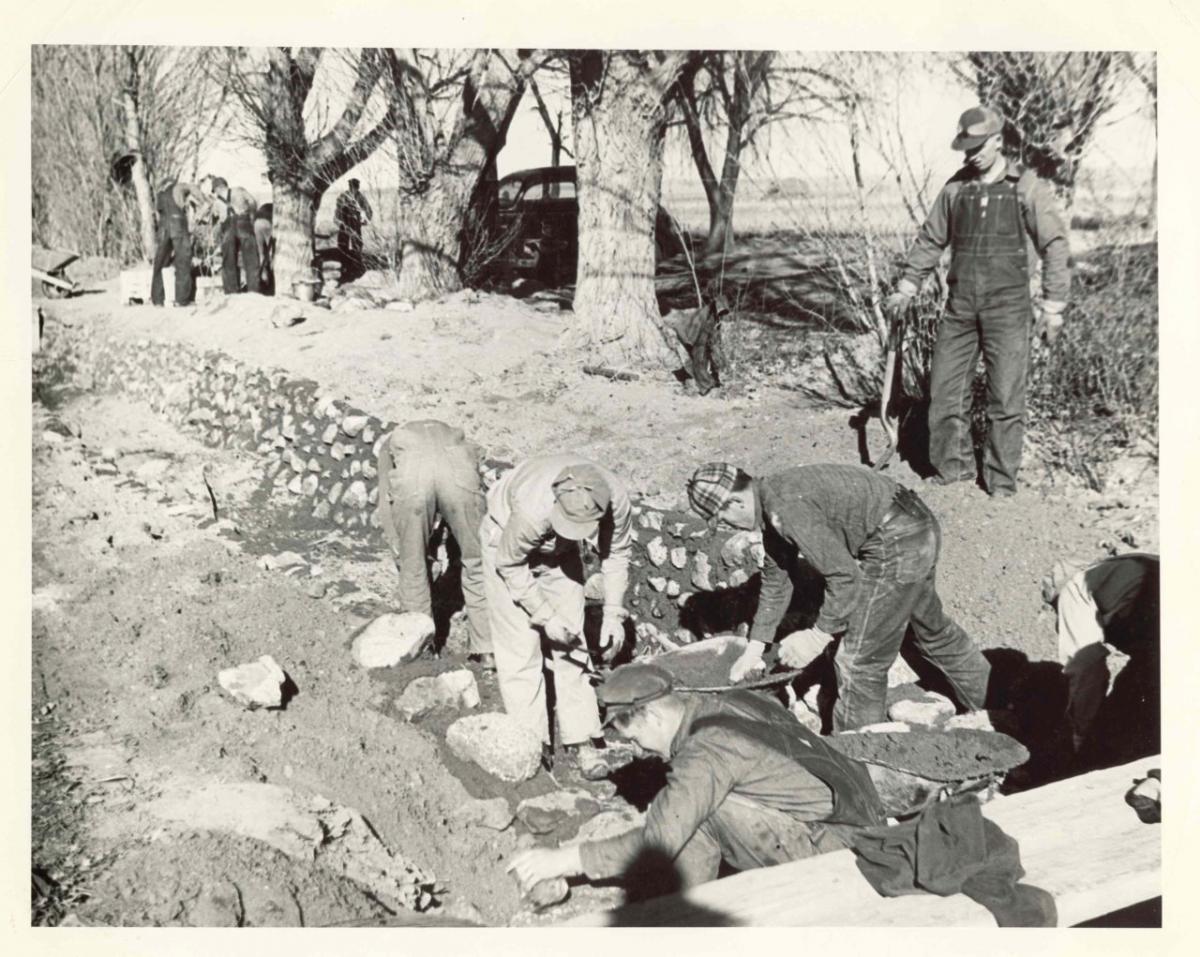 CPS Camp No. 5, Colorado Springs, Colorado.Nine men lining irrigation ditches with stone and cement.Digital image, Photo #4. Box 1, Folder 9. MCC Photographs, Civilian Public Service, 1941-1947. IX-13-2.2. Mennonite Central Committee Photo Archive
CPS Camp No. 5, Colorado Springs, Colorado.Nine men lining irrigation ditches with stone and cement.Digital image, Photo #4. Box 1, Folder 9. MCC Photographs, Civilian Public Service, 1941-1947. IX-13-2.2. Mennonite Central Committee Photo Archive -
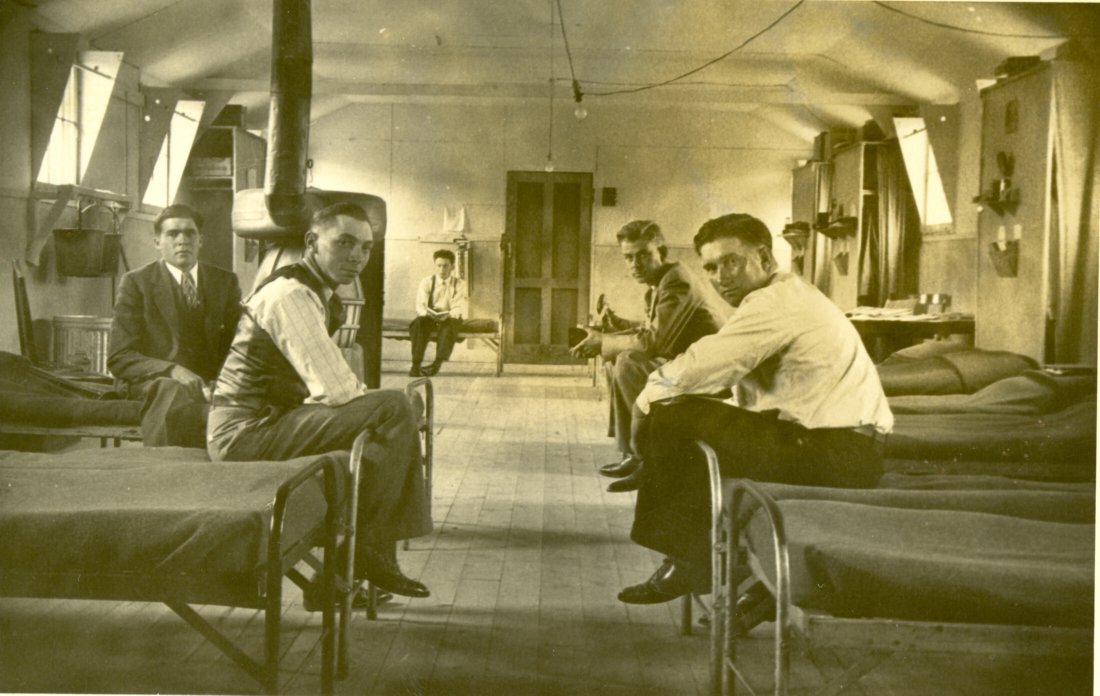 CPS Camp # 5, Colorado Springs, ColoradoSunday afternoon in a dormitoryPhoto # 793. Box 1, Folder 9. MCC Photographs, Civilian Public Service, 1941-1947. IX-13-2.2. Mennonite Central Committee Photo Archive
CPS Camp # 5, Colorado Springs, ColoradoSunday afternoon in a dormitoryPhoto # 793. Box 1, Folder 9. MCC Photographs, Civilian Public Service, 1941-1947. IX-13-2.2. Mennonite Central Committee Photo Archive -
 CPS Camp # 5, Colorado Springs, ColoradoDiversion DitchesPhoto # 240. Box 1, Folder 9. MCC Photographs, Civilian Public Service, 1941-1947. IX-123-2.2. Mennonite Central Committee Photo Archive.
CPS Camp # 5, Colorado Springs, ColoradoDiversion DitchesPhoto # 240. Box 1, Folder 9. MCC Photographs, Civilian Public Service, 1941-1947. IX-123-2.2. Mennonite Central Committee Photo Archive. -
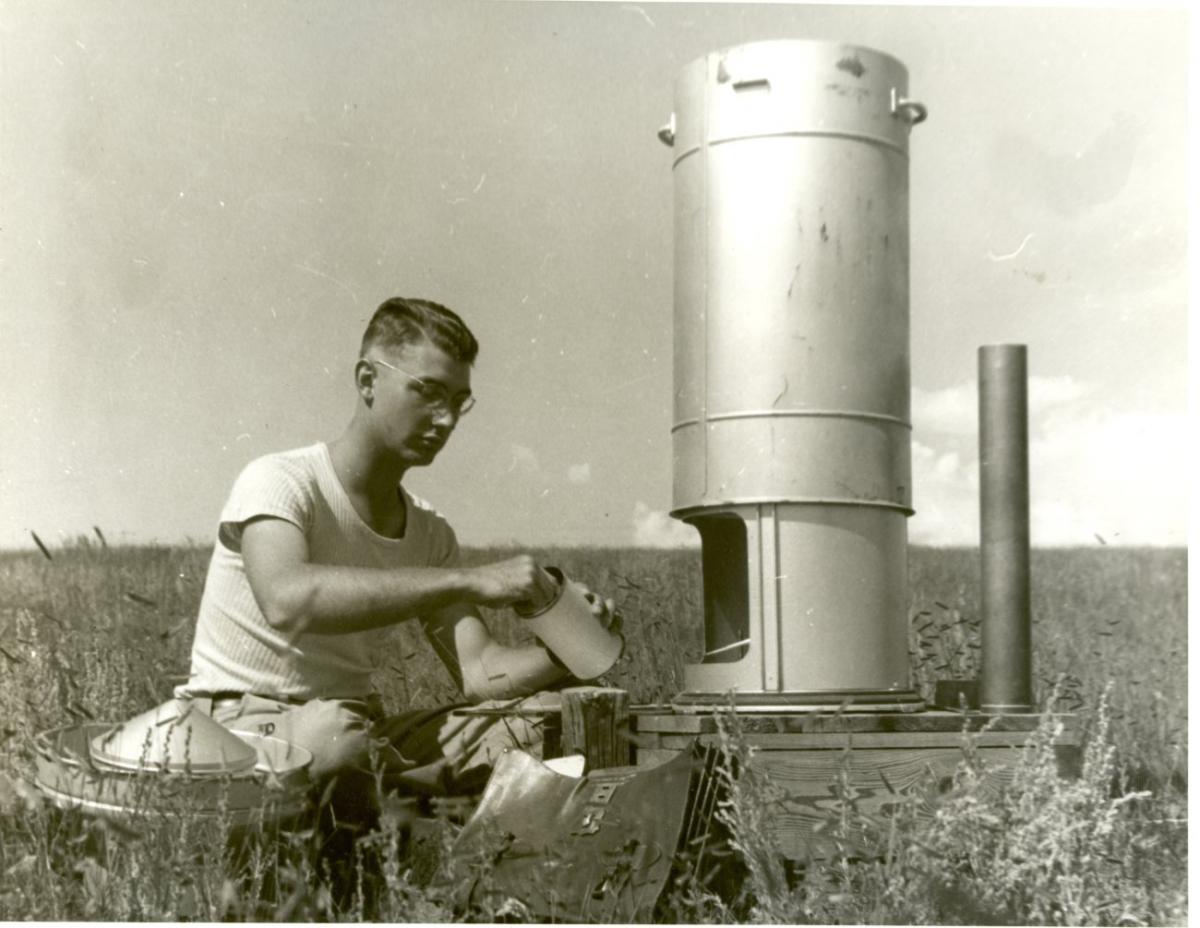 CPS Camp # 5, Colorado Springs, ColoradoChecking rainfall and run off on watersheds near Colorado Springs.Photo # 244. Box 1, Folder 9. MCC Photographs, Civilian Public Service, 1941-1947. IX-13-2.2. Mennonite Central Committee Photo Archive.
CPS Camp # 5, Colorado Springs, ColoradoChecking rainfall and run off on watersheds near Colorado Springs.Photo # 244. Box 1, Folder 9. MCC Photographs, Civilian Public Service, 1941-1947. IX-13-2.2. Mennonite Central Committee Photo Archive. -
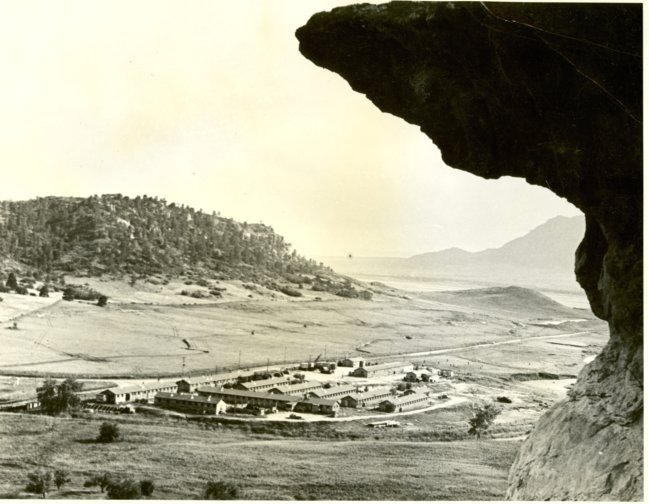 CPS Camp No. 5Colorado Springs, Colorado, Camp 5.Photo #245. Box 1, Folder 9. MCC Photographs, Civilian Public Service, 1941-1947. IX-13-2.2. Mennonite Central Committee Photo Archive
CPS Camp No. 5Colorado Springs, Colorado, Camp 5.Photo #245. Box 1, Folder 9. MCC Photographs, Civilian Public Service, 1941-1947. IX-13-2.2. Mennonite Central Committee Photo Archive -
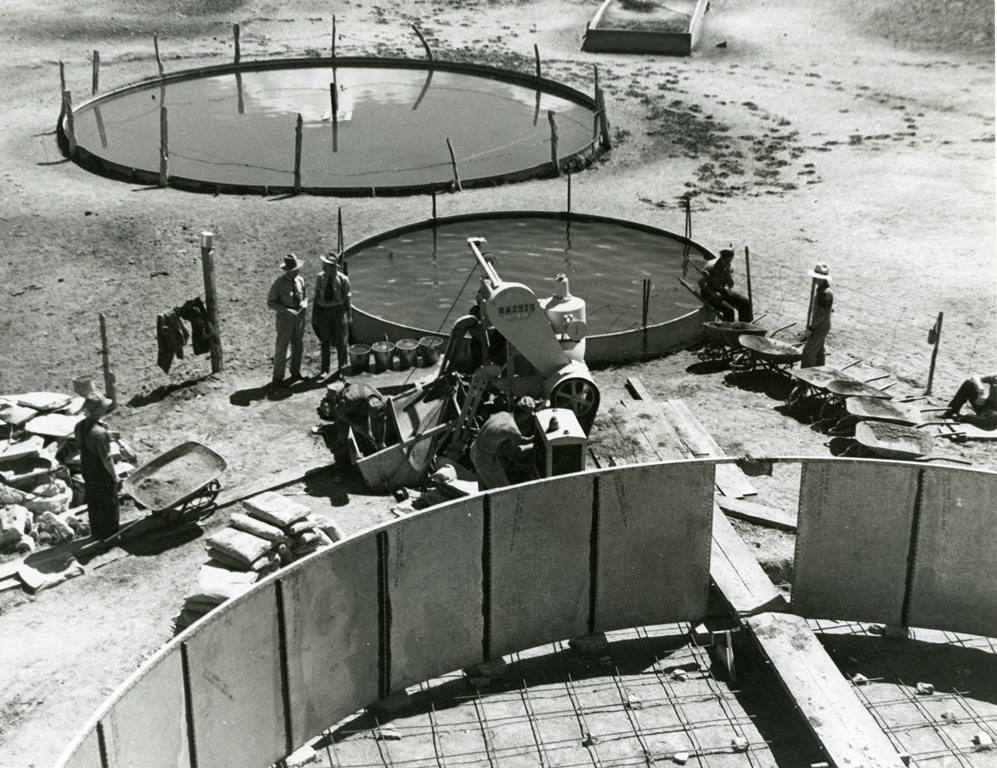 Construction of water tanks for water conservationConstruction of water tanks for water conservationMennonite Central Committee Archival Photo
Construction of water tanks for water conservationConstruction of water tanks for water conservationMennonite Central Committee Archival Photo -
 Basketball: CPS Camp # 5, Colorado Springs, COBasketball: CPS Camp #5 Colorado Springs, COMennonite Central Committee Archival Photo
Basketball: CPS Camp # 5, Colorado Springs, COBasketball: CPS Camp #5 Colorado Springs, COMennonite Central Committee Archival Photo
CPS Camp No. 5, a Soil Conservation Service base camp was located in a former Civilian Conservation Camp three miles northeast of Colorado Springs. The Mennonite Central Committee operated the camp, which opened in June 1941 and closed in May 1946. The men worked on soil conservation irrigation projects.
This Soil Conservation Service base camp was located in a former Civilian Conservation Camp three miles northeast of Colorado Springs between Pikes Peak to the west and Austin Bluffs to the east. It bordered eroding farm land to the east and south.
Directors: Albert Gaeddert, Emmanuel Hertzler, Harry Martens, Albert Bohrer, David Suderman, Paul Schmidt, David Ebersole
Dietician: Mildred Buhr, Marie Groening, Edna Kauffman, Florence Heineman Wenger
Matron: Mrs. John H. Gaeddert, Myrtle Schnell Hertzler, Selma Linscheid,
Nurse-Matron: Selma Bartel, Carmen Bohrer, Alice Suderman
Camp capacity was one hundred-sixty-five men. Camp statistics revealed a more cosmopolitan group than found in some Mennonite Central Committee camps. As of October 1, 1942, the one hundred-forty-three men came from twelve states, ten different branches of the Mennonite Church and from thirteen other denominations. A number of the men were married.
In general, men in Mennonite camps and units tended to report affiliation with Mennonite denominational groupings when entering CPS.
Typically, men in Mennonite camps and units when entering CPS had reported farming or other agricultural work as their occupation. The men on average had completed 10.45 years of education when entering CPS. (Sibley and Jacob pp. 171-72)
Rapid mountain streams eroded soils and flooded tableland; areas between rivers needed irrigation. The work included:
building irrigation ditches and diversion boxes to prevent soil washing; building dams. . .for irrigation purposes and stock water; leveling land with heavy equipment to allow tillage and irrigation with minimum loss of soil;. . .repairing of Government mechanical equipment; building fences. . .; reseeding pastures; and similar projects.
--Paul Schmidt, camp director, July 7, 1945 letter (Gingerich p. 110)
The men completed a large dam across the Fountain River which supplied adequate water for two irrigation systems. In a side camp at Trinidad, Colorado one hundred thirty miles away, twenty-five men rebuilt a washed-out dam on the Purgatoire River so that irrigation water could again flow to the farmers in the area. Work required surveying. Roughly twenty-five percent of the men performed emergency farm work, since many farmers were at war. Some assignees planted several million trees in the Pike National Forest, and others shingled the roof of the Summit House on Pikes Peak.
The COs performed over sixty different kinds of jobs in the field and at the camp. The first group to arrive repaired and cleaned up the camp buildings. During the life of the camp, men also worked in the kitchen, laundry, as nightwatchman, and performed other duties associated with camp operation and maintenance.
Camp men, active in governance of the camp, created standards of conduct. The multiple points of view represented among the men added value to programs and activities of the camp.
Making hooked rugs and turning wood became leading hobbies at the camp. Dale, Elmer and Kelly Palmer, were paroled from federal prison for failing to register and assigned to the CPS camp. They brought the rug craft with them.
J. Hobart Goering helped organize the many good singers at the camp, directed the choir and sang in an octet. The groups not only sang for services at the camp, but also at churches in town. (in The Eden Peace Witness pp. 72-79)
Robert Kreider was appointed educational director for the camp and Ray Schlichting as business manager. Both continued to serve the Mennonite Central Committee in a variety of roles until 1948, “thus giving the longest terms of service” of any appointees. (Gingerich p. 114)
A three weeks crafts school taught by David Kope in June 1945 at Denison, Camp No. 18, trained men from several camps, including Colorado Springs, to serve as craft leaders.
From 1944 on, one of the men at Colorado Springs served as a project training assistant. He would work with both the camp director and the work superintendent. He prepared orientation courses for new assignees, job training for the work project, general training and orientation to work responsibilities, assisted the educational director in leisure time training courses in the camp education program, and prepared records and reports for the technical agency.
The men published a camp paper Pike View News from September 6, 1941 through January 1945. It offered a record of camp activities for the men, helped interpret camp efforts, and reported major events for friends and others.
The camp enjoyed good relations with the community of Colorado Springs. Camp men regularly engaged in softball and other sports contests with the YMCA. The Colorado Springs community rallied in support of the camp when in the spring of 1943 it was rumored that the camp was to be closed.
In July 1942 the men at CPS Camp No. 21 at Cascade Locks protested the order to have George Kiyoshi Yamada discharged from CPS so that he might be assigned to a Japanese internment camp. Selective Service and the War Relocation Authority agreed to allow Yamada to transfer to an inland camp and in late July 1942 he moved to CPS Camp No. 5 in Colorado Springs where he worked on the dishwashing crew. In his three years at Colorado Springs, he participated in a Congress of Racial Equality civil rights project to racially integrate the theaters in town. Yamada spent eight days in the El Paso County jail.
By January 1945, forty wives had moved to Colorado Springs and the community often advertised for “Mennonite women” to fill jobs. In the base camps, men could not stay with their wives overnight and “an eleven p.m. bedcheck” enforced the Selective Service policy. Wives often faced challenging living conditions. Since both a military base and a CPS camp were near Colorado Springs, military and CO wives often lived nearby in apartments or flats. Barbara Thomas, an Amish Mennonite woman, after completing the cotton harvest in Oklahoma, followed her husband to Colorado Springs. (Goossen p. 53) Many wives volunteered as nurses, dieticians, matrons and their contributions to camp morale were invaluable.
Not only CPS wives, but also pacifist women sought to work in support of men in the CPS camps. Louise Evans, a Vassar College student wrote to CPS in 1942 asking to serve at the camp while spending the summer in her parents’ Colorado Springs home. (Goossen p. 53)
See The Eden Peace Witness: A Collection of Personal Accounts edited by Jeffrey W. Koller. Moundridge, KS: Jebeko Publishing, 2004.
For more information on soil conservation, camp work and life, and relations with Colorado Springs see Melvin Gingerich, Service for Peace: A History of Mennonite Civilian Public Service. Akron, PA: Mennonite Central Committee printed by Herald Press, Scottdale, PA 1949, Chapter X pp. 108-114.
For more information on women COs see Rachel Waltner Goossen, Women Against the Good War: Conscientious Objection and Gender on the American Home Front, 1941-47. Chapel Hill, NC: The University of North Carolina Press, 1997.
For more information on soil conservation work, see Albert N. Keim, The CPS Story: An Illustrated History of Civilian Public Service. Intercourse, PA: Good Books 1990, pp. 49-55.
For information concerning the Yamada protest see Jeffrey Kovac, Refusing War, Affirming Peace: A History of Civilian Public Service Camp #21 at Cascade Locks. Corvallis, OR: Oregon State University Press 2009, pp. 63-75.
See Robert S. Kreider, “CPS: A Year of Service With Like-Minded Christian Young Men”, CPS Camp No. 5, Colorado Springs, Colorado, 1941-42,” Mennonite Quarterly Review 66 (October 1992): 546-79.
See also: Charles Davis and Jeffrey Kovac, "Confrontation at the Locks: A Protest of Japanese Removal and Incarceration during World War II". Oregon Historical Quarterly Volume 107, Number 4 (Winter 2006), pp.486-509.
See also Mulford Q. Sibley and Philip E. Jacob, Conscription of Conscience: The American State and the Conscientious Objector, 1940-1947. Ithaca, NY: Cornell University Press, 1952.
Swarthmore College Peace Collection, Camp periodicals database.
George Yamada describes his CPS experience including the time at Colorado Springs in George Yamada, “My Story of World War II,” in Larry Gara and Lenna Mae Gara, A Few Small Candles: War Resistors of World War II Tell Their Stories. Kent, OH, and London: Kent State University Press, 1999.

